February 2022: Daffodil time
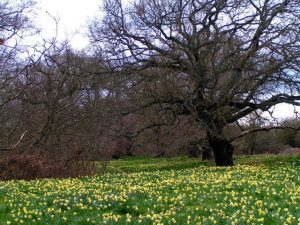
Most of our daffodils are cultivated varieties but there are still some genuinely wild daffodils in Britain, sadly now limited to relatively few sites. The wild ones are smaller and daintier than the cultivars, with a characteristic ‘two-tone’ effect of paler petals surrounding a darker yellow trumpet. They used to flourish widely in damp meadows and old woodlands, many of which have now been destroyed for ‘development’, but you can still see them at various sites in SW England and we have a wonderful display of them in one place in Suffolk – Butley Woods near Orford. The most famous wild daffodils, however, must be those in the Lake District, which were celebrated in William Wordsworth’s poem, ‘I wandered lonely as a cloud’. Wordsworth was inspired to write this by a walk he took with his sister Dorothy in 1802 at Ullswater, where they delighted in the glorious profusion of daffodils along the lake shore:
Ten thousand saw I at a glance
Tossing their heads in stately dance
The poem’s a national favourite, of course, but what may be less well known is that William cribbed some of his best lines from the diary notes of his sister Dorothy, who was a very good and attentive naturalist. Poetic licence? Or sexist sibling rivalry?
Matching flowers to months is becoming more difficult, though. William and Dorothy’s epiphany was in April not March, and scientists have calculated that as the climate heats up plants are now flowering 42 days earlier than the average date before 1986. Nice in a way, but this creates serious disruptions to nature’s careful synchronisation of things like the hatching of bird chicks with the emergence of caterpillars; while farmers could lose a whole crop of flowering fruit trees to a late frost. Maybe the florists will prove right and we will one day have wild carnations blooming in January, but be careful what you wish for.
Jeremy Mynott
6 February 2022
March 2022: Despite everything, spring!
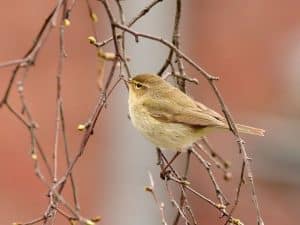
I’m writing this on 4 March. The forecast yesterday was for a mild night with a light southerly breeze and I felt something special might be about to happen, a little annual miracle that means more to me every passing year. So I went out at first light, senses flaring and on full alert. I only had to walk a short way down the Drift before I heard it – a clear double refrain in the still morning air, chiff-chaff, chiff-chaff. ‘YES’, I shouted, and punched the air like a demented football fan. The chiffchaff had returned – on exactly the same day as last year and even to the very same bush. Magic! The chiffchaff is just a tiny olive-green warbler, weighing no more than a 2p piece, but it’s always the first migrant to make the long journey back to Thurlow. I listen out for it eagerly every March and think of it surfing the green wave of spring that travels steadily north across Europe, bringing with it a new season of light, warmth and growth. Twenty years ago, the first chiffchaff would arrive here about 15 March, and forty years ago 31 March – that’s global warming for you, but the thrill has been the same each time.
This year is different in another way, though. It’s just as exciting to hear this herald of spring again, but it’s terribly poignant. The news from Ukraine is almost unbearable and other, human, migrants are streaming across Europe in despair. It will soon be the spring equinox, the moment in the year when ‘night equals day’ and the forces of darkness and light are in equilibrium. That’s a perfect metaphor for this conjunction of destruction in the human world and rebirth and renewal in nature. I had the same feeling in March 2020 when the Covid pandemic first took a grip, right at the start of one of the best springs in living memory. The spring was unstoppable then and so it will be again this year, just as the tides will rise and fall every day, regardless of human disasters. And we can find hope, beauty and consolation in these natural rhythms, of which we are an integral part, if we respond to them fully. That’s not evading the bad news but counteracting it.
You can listen to the chiffchaff’s onomatopoeic song, if you just google ‘chiffchaff song’ – there are several different recordings. Some old country names represent this as chip-chop, chit-chat, siff-siaff (Welsh) or tiuf-teuf (Irish); while the Dutch call it tjift-tjaf and the Germans zilp-zalp. Whatever the language, by the time you read this the chiffchaffs will have arrived all over Europe, with the promise of spring in their songs.
Jeremy Mynott
Lavender Cottage
April 2022: In praise of life
One of these days we shall wake up and hear that David Attenborough has died. There will then be deep and widespread national mourning, since he has become a sort of secular saint – a new St Francis of the birds and animals. But one should praise people while they are still alive and with us, not just write solemn obituaries when they are dead, so here goes.
For years Attenborough has been our guide to the natural world – infectiously enthusiastic, knowledgeable and, what is not at all the same thing, wise. It has become a sort of televisual cliché, but now an addictive one: the camera shows us some impossibly remote and inhospitable terrain from a great height; we pick out a tiny, distant figure in the wilderness of ice, marshland or desert; the picture zooms slowly in; and there is Attenborough, spreading his arms outwards to welcome us in, swaying around somewhat erratically to emphasise his words, and telling us, almost confidentially, in that so familiar, slightly hoarse voice, ‘And here, even in these extreme conditions, there is life, abundant life, and just over here behind me is something really quite extraordinary …’ .
In his autobiography he tells the story of his first job-interview with the BBC. His interviewer recommended that he be given a job, but should on no account be allowed in front of a camera, because of his peculiar facial movements and body language. This is precisely his great charm, however. He has the priceless gift of conveying his sense of wonder and excitement about the natural world in a way we can share and can see to be genuine. He is the perfect guide and intermediary, who invites us in and then lets us see what he saw and enjoy our own reactions. So many other presenters seem over-rehearsed by comparison. They spend more time presenting themselves than the wildlife, and their flirty chit-chat and highly staged conversations just get in the way.
I once heard Attenborough give a talk. The hall was packed, of course, and at the end of his spellbinding performance the chairman invited questions. A little boy at the front shot up his hand and asked in piping tones, ‘Please, Sir, how can I be like you when I grow up?’ The audience collapsed. But the great man took him seriously and said, ‘Well, the first thing you might do is go outside in your garden and look hard at something. I mean look really closely, for a long time, and then try to draw or write down what you saw and think of some questions to ask. It may become a habit.’
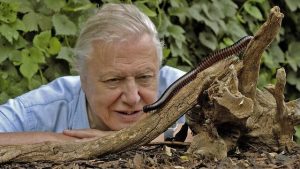
Jeremy Mynott
April 2022
May 2022: a Suffolk success story
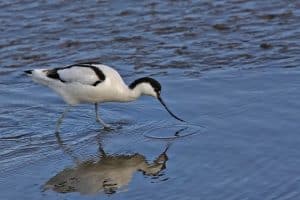
Even if you’ve never seen a real avocet – and I’m afraid you won’t see one in Thurlow – you must have seen an image of one, since they have long been the official RSPB logo and appear everywhere on their badges, signs and products. This was a very shrewd commercial choice by the RSPB, since not only are the birds beautiful to look at but they are also the perfect symbol of a great conservation success story. Avocets disappeared from Britain as a breeding species in the nineteenth century, as a consequence of human persecution and wetland drainage, but they miraculously reappeared in 1947 just after the end of World War 2, ironically returning to a habitat of flooded farmland and marshland which had been deliberately created as part of our coastal defences against potential invaders. The birds found their own way back to the Suffolk coast at two places: Minsmere, which is now the premier RSPB reserve in the country, and Havergate Island in the Ore estuary, where they bred successfully under conditions of high security (the RSPB even had a secret code name for the place – Zebra Island’). Since then avocets have spread along the whole East Anglian coast in suitable habitats, and you can find them in various breeding colonies as well as in wintering flocks. So, let’s celebrate our Suffolk avocets as a happy symbol of national recovery and regeneration – the return of a native.
Jeremy Mynott
Lavender Cottage
June 2022: time to fly
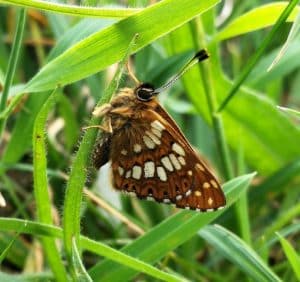
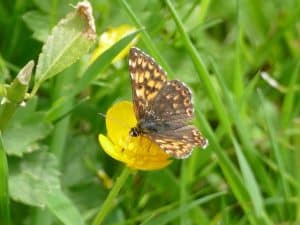
You have to be at just the right place and time to see a Duke of Burgundy nowadays. The time is a short window in mid-May, and this is one of the few places. You have to be in the right posture, too, which is on your hands and knees, peering around to catch sight of the male perched on a stem, from which it sallies forth in short bouncy flights to drive other males off its little kingdom. Just think, you have the whole of southern Britain to choose from and you have to defend to the death your one minute little patch (maybe a parable coming on here …). The weather wasn’t great. Butterflies need it to be at least 14° C to warm their bodies sufficiently to fly and it was a cool, blustery day, threatening rain. But the clouds parted briefly and there was a sudden pulse of warmth from the sun. Almost immediately butterflies appeared, as if from nowhere: peacocks, tortoiseshells, red admirals, small brown jobs like grizzled and dingy skippers, and at last … yes, a freshly minted Duke, clinging to a buttercup.
The vision lasted only a few minutes. The clouds closed in and the rain came. But as the great Indian poet, Rabindranath Tagore said, ‘The butterfly counts not in months but moments, and has time enough’.
Jeremy Mynott
July 2022: Survival tactics
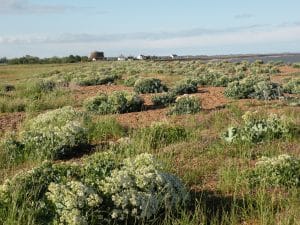
You have to be tough to survive at Shingle Street – if you’re a plant on the shingle banks, that is. Just imagine. You’re regularly doused with salt spray, exposed to constant winds and parched by the sun; there’s no fresh water and almost no soil; while the shingle itself is unstable and constantly shifting. It’s an extreme environment, a desert of stones. Yet there is a community of plants out there that have evolved specialised tactics to cope with those harsh conditions:
- Lie flat to shelter from the winds (orache and sea-pea)
- Have very deep roots to suck up moisture (sea-kale, whose roots can go two metres deep)
- Have shiny leaves to reduce water loss (sea-beet) or hairy ones (yellow-horned poppy)
- Grow in matted clumps to bind you firmly to the shingle (sea-pea, stonecrops and sea-campion)
We are blessed by our thriving shingle bank colony of these rare and beautiful plants. It’s one of the most important in Britain, which is why Shingle Street is designated an SSSI (Site of Special Scientific Interest). We therefore inspect the plants regularly to check on their condition and a dedicated team of local volunteers has just completed the latest detailed survey, whose results will appear in due course on the Shingle Street website.
We did observe several changes. The sea kale is now very abundant, popping up everywhere like huge cauliflowers. The sea pea has spread too and there are large drifts of it in new areas. Its clustered purple flowers fade to blue later and are then succeeded by succulent seed pods, which are said to have once staved off starvation on the Suffolk coast during a famine in the seventeenth century (but they can cause paralysis if eaten in quantity, just in case you were tempted). Scattered amongst these are other shingle specialists like orache (much scarcer this year), sea beet, sea-campion, curly dock, viper’s bugloss, buckshorn plantain, stonecrop and the striking yellow-horned poppies (beautiful, but classified as a toxic weed in North America, and containing hallucinogens).
The most striking change, however, is in the expansion of the grasses that now cover the shingle ridges nearer the houses. That is evidence that the banks have accumulated depositions of soil and have to that degree stabilised – with the further benefit that hares and skylarks are now exploiting this new emergent habitat, along with various butterflies, moths and bush-crickets. That’s all the more reason to ask visitors to help us conserve this precious environment. For there is one other tactic these vulnerable plants need to survive, this one more under our control than theirs:
- Don’t get trampled on.
Thank you.
Jeremy Mynott
10 July 2022
August 2022: Moth matters
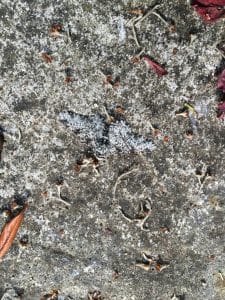
Mention moths and most people immediately think of clothes moths. These are the moths referred to in the Bible, where we are advised not to lay up our treasures on earth ‘where moth and rust doth corrupt’. But there are only two kinds of clothes moths in the UK – really tiny ones, and in any case it’s their larvae (caterpillars) that cause the problem. You might be amazed just how many other kinds of moths there are out there – some 2,500 kinds in the UK as a whole. And an expert moth-er (don’t forget the hyphen) can find several hundred of these in their own back gardens, as I have in mine over the years. Most moth species were first identified and named by naturalists like Linnaeus in the eighteenth and nineteenth centuries and they bequeathed to us this wonderful lexicon of names, not just the animal ones mentioned above but a whole treasury of footmen, quakers, wainscots, rustics, lutestrings, carpets, tussocks, darts and daggers. There are also some wittily intriguing ones like the Uncertain, the Suspected and the Confused. How splendid, too, to know that we have living amongst us here in the village a Setaceous Hebrew Character, a Pebble Prominent and the lovely Merveille du Jour.
Moths matter. They’re an index of the health of our environment. Readers of my generation will remember the ‘moth snow-storms’ we used to get years ago, splattered on our car windscreens at night. Not anymore. Despite the astonishing diversity I mention above, moth abundance has declined dramatically in recent years along with so much other insect life. Disastrously so, too, since moths are a key part of the larger eco-system: they pollinate plants, and their caterpillars are a crucial food-source for birds, just as the adults themselves are for bats and some nocturnal birds like nightjars. Hence the elaborate camouflages they adopt – as in the featured Peppered Moth, if you can spot it, blending perfectly with the blotches on my paving.
Moths are also beautiful when you see them close-up. Take a look at the ones pictured on the Shingle Street website, for example, under Gallery: (https://www.shinglestreetsurvey.org.uk/gallery/nggallery/shingle-street-survey/moths). Shingle Street is a tiny village on the Suffolk coast but well over 400 moth species have been identified there. It’s maybe heretical to say it, but these subtly designed moths make the gaudier butterflies look almost vulgar.
Jeremy Mynott
September 2022: Record breakers
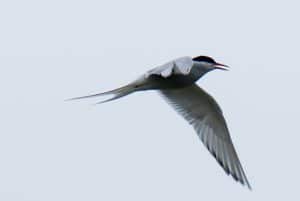
There’s a definite feeling of autumn in the air, as the winds freshen and the nights draw in again after those seemingly endless days of summer light and warmth. The birds felt the change before we did, however, and there’s been a steady stream of swallows since mid-August heading back south to their winter quarters. The journeys these birds will make across Europe to southern Africa are truly amazing – they will pass unguided across seas, over mountains and deserts, and into tropical regions where they will exchange the everyday sight of the cows and sheep here for one of herds of antelope and zebra there, all equally familiar to them.
But even these long-distance migrants are outdone by what we are now learning about the ultra-marathoners crossing the Pacific. Scientists have been tagging some waders that breed in Alaska with tiny satellite transmitters and following them on their journeys to Australasia. They have discovered to their amazement that one species in particular has been breaking all known records for non-stop flight. The bar-tailed godwit is a large wader you can actually see on the Suffolk coast in winter and these birds will have come south to us from Siberia, where they breed on the tundra; but to the west of Siberia there are populations of the same species breeding in Alaska and they migrate all the way down to Australia and New Zealand over the Pacific. And what the scientists have now discovered is that they can do it in one non-stop journey – just imagine, some 8,000 miles without a pit-stop or a break, flying continuously at about 40mph. The godwits have been clocked making this vast journey in nine days of continuous flight, without once stopping to feed or drink. How do they manage it? Well, before they leave Alaska they deliberately fatten themselves up on clams and worms to carry enough fuel in the form of protein to last them the whole way. So, they start fat and end thin, very thin.
The champion traveller of all, however, is the arctic tern. They summer in the Arctic and then go to the far end of the earth, across the date line and the equator, and into the ‘southern summer’ of the Antarctic, over 12,000 miles away. The terns have it easier than the godwits in one way, in that they feed on small fish and can eat as they go, but over a lifetime of such journeys it is estimated that they fly the distance a spaceship would cover if it went to the moon and back three times. That’s the ultimate commute and the price they pay for perpetual summer.
Jeremy Mynott
13 September 2022
October 2022: Web sights
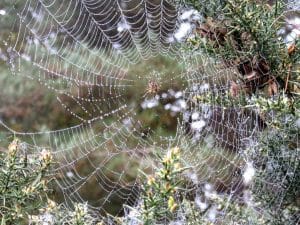
Most of the UK’s 650 species of spider – bet you didn’t realise there were so many – live outside anyway. Among the wonders of autumn are those soft , misty mornings when you go out into the garden and see a perfect spider’s web outlined with beads of dew. The architecture of these silvery webs is breath-takingly beautiful. The spider first puts in the spokes to establish the structure and tether it securely to its moorings, then adds the complex spiral strands with a special sticky kind of silk that will trap unwary insects. The spider herself has anti-stick feet – all eight of them – to navigate the web. As a construction material the silk has extraordinary properties. It’s five times stronger than steel, weight for weight, but so light in density that a strand of spider’s silk stretched right round the earth would still only weigh the same as a bag of sugar. You can make bullet-proof vests from spider’s silk. It has medical uses, too, as a gentle anti-septic for binding wounds. Miss Muffet may in real life have been the daughter of the famous sixteenth-century naturalist, Dr Thomas Muffet, who discovered this property. Shakespeare knew about it anyway. In his Midsummer Night’s Dream he refers to the curative powers of one of Titania’s attendant fairies called Cobweb (‘Cob’ is the old name for spider). And we honour spiders, at least metaphorically, by naming one of the most important modern inventions after their magical creations – the World Wide Web.
Jeremy Mynott
7 October 2022
November 2022: Remember, remember….
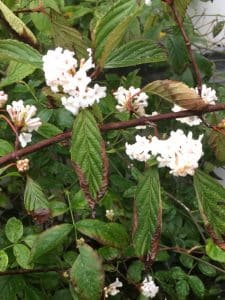
No warmth, no cheerfulness, no healthful ease,
No comfortable feel in any member –
No shade, no shine, no butterflies, no bees,
No fruits, no flowers, no leaves, no birds –
November
Very evocative – except that it’s all wrong now. You need to remember that poor old Thomas Hood, who died at the age of just 45, wrote this in London in 1844 at a time when the city was often choked with thick smog and winters were much colder than now. None of his examples really apply today. We’ve just had some of the warmest autumn days ever, and I seem to have plenty of feeling left in the members that matter. Moreover, there are still green leaves on the trees. And I had to cut my lawn again last week – unthinkable even 50 years ago, let alone in Hood’s time. I also saw and heard quite a few birds today. Robins, wrens and a song thrush were all singing and the hedgerows were laden with autumn fruits for foraging winter migrants. Amazingly, I even saw a butterfly on the wing, too – a showy red admiral, nectaring on the late-flowering ivy. Indeed, some of last summer’s roses are still in flower, as well as next year’s daphne. It’s all topsy-turvy.
You might think it’s nice to see some life and colour so late in the year, but in truth we know it’s a terrible warning, a disturbance to the natural order that is already a crisis in some parts of the world and is rapidly heading our way. The political news is full of trivial distractions – think no further than the MP for West Suffolk – but there is just one subject that should preoccupy us. It’s the one government leaders are discussing at COP 27 in Egypt as I write. Call it the Environment, Biodiversity, Sustainable Growth or what you wish, but I like the older and richer idea of Nature. No one ever wrote a poem to Biodiversity, but our literature, arts, traditions and whole culture are all saturated with references to Nature as the source of some of our deepest emotions. Not surprising, really, since we are ourselves a part of nature.
So, remember, remember the fifth of November, and put a bomb under the government – just metaphorically, of course.
Jeremy Mynott
5 November 2022
